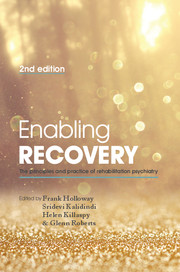Book contents
- Frontmatter
- Contents
- List of contributors
- List of figures, tables and boxes
- Preface
- Part 1 Setting the scene
- Part 2 Treatment approaches
- 7 Treatment approaches: overview
- 8 Rehabilitation at the coalface: practical approaches to helping people improve their functional skills
- 9 Cognitive approaches: cognitive–behavioural therapy and cognitive remediation therapy
- 10 Family interventions
- 11 Working with challenging behaviour
- 12 Working with coexisting substance misuse
- 13 Creative therapies and creativity
- 14 Management of medication when treatment is failing
- 15 Physical healthcare
- Part 3 Key elements of a rehabilitation service
- Part 4 Special topics in psychiatric rehabilitation
- Part 5 Future directions
- Index
9 - Cognitive approaches: cognitive–behavioural therapy and cognitive remediation therapy
from Part 2 - Treatment approaches
Published online by Cambridge University Press: 02 January 2018
- Frontmatter
- Contents
- List of contributors
- List of figures, tables and boxes
- Preface
- Part 1 Setting the scene
- Part 2 Treatment approaches
- 7 Treatment approaches: overview
- 8 Rehabilitation at the coalface: practical approaches to helping people improve their functional skills
- 9 Cognitive approaches: cognitive–behavioural therapy and cognitive remediation therapy
- 10 Family interventions
- 11 Working with challenging behaviour
- 12 Working with coexisting substance misuse
- 13 Creative therapies and creativity
- 14 Management of medication when treatment is failing
- 15 Physical healthcare
- Part 3 Key elements of a rehabilitation service
- Part 4 Special topics in psychiatric rehabilitation
- Part 5 Future directions
- Index
Summary
Introduction
The cognitive underpinnings of schizophrenia took some time to be recognised, despite the phenomenology including cognition as a main distinguishing factor in all diagnostic descriptions over the past 100 years. Thinking was described as problematic because of two issues: poor communication, engendered through either delusional thinking or the problems of understanding syntactically or semantically disorganised language; and the cognitive problems in memory, concentration and attention described by patients, or cognitive disorganisation or loose associations as described by Kraepelin and Bleuler. It is only relatively recently that these phenomena have been the focus of targeted treatments in psychology, in the form of cognitive–behavioural therapy for psychosis (CBTp) and cognitive remediation therapy (CRT). These approaches take their roots in the two different aspects of poor cognition but have now begun to move together under the guise of metacognition. Both ascribe the problems of cognition as part of the disorder and this has now been recognised in the new version of the Diagnostic and Statistical Manual (DSM-5; American Psychiatric Association, 2013).
This chapter sets out the two broad psychological approaches, their similarities and differences. The evidence base for both therapies is similar, as are their effect sizes (Wykes et al, 2008, 2011). At the time of writing, CBTp is firmly recommended within evidence-based guidelines for the treatment of schizophrenia. CRT has not yet achieved this level of recognition, although a recently published national guideline, from Scotland, states that: ‘Cognitive remediation therapy may be considered for individuals diagnosed with schizophrenia who have persisting problems associated with cognitive difficulties’ (Scottish Intercollegiate Guidelines Network, 2013).
Historical context
Although single case reports of psychological interventions for psychosis date back more than 50 years (e.g. Beck, 1952), significant developments in this area did not occur until the 1980s. Early behavioural interventions were aimed at symptom management and were predominantly embedded within the traditional psychiatric view of schizophrenia. However, the development of cognitive–behavioural models for affective disorders had a significant impact on psychosis research during the late 1990s. This work highlighted the extent to which the development and maintenance of symptoms could be understood with reference to psychological processes. The traditional view that schizophrenia symptom content should be ignored was challenged and therapists began to examine the content of psychotic symptoms directly and to use this dialogue as a basis for collaborative discussion.
- Type
- Chapter
- Information
- Enabling Recovery , pp. 136 - 152Publisher: Royal College of PsychiatristsPrint publication year: 2015



